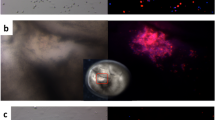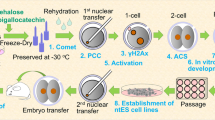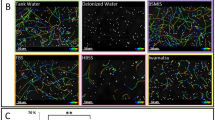Abstract
Since the advent of procedures for cloning animals, conservation biologists have proposed using this technology to preserve endangered mammals. Here we report the successful cloning of a wild endangered animal, Ovis orientalis musimon, using oocytes collected from a closely related, domesticated species, Ovis aries. We injected enucleated sheep oocytes with granulosa cells collected from two female mouflons found dead in the pasture. Blastocyst-stage cloned embryos transferred into sheep foster mothers established two pregnancies, one of which produced an apparently normal mouflon. Our findings support the use of cloning for the expansion of critically endangered populations.
This is a preview of subscription content, access via your institution
Access options
Subscribe to this journal
Receive 12 print issues and online access
$209.00 per year
only $17.42 per issue
Buy this article
- Purchase on Springer Link
- Instant access to full article PDF
Prices may be subject to local taxes which are calculated during checkout


Similar content being viewed by others
References
Hilton-Taylor, C. (compiler). 2000 IUCN red list of threatened species. (IUCN/SSC; Gland, Switzerland and Cambridge, UK; 2000).
Margules, C.R. & Pressey, R.L. Systematic conservation planning. Nature 405, 243–253 (2000).
Myers, N., Mittermeier, R.A., Mittermeier, C.G., da Fonseca, G.A.B. & Kent, J. Biodiversity hotspots for conservation priorities. Nature 403, 853–858 (2000).
Corley-Smith, G.E. & Brandhorst, B.P. Preservation of endangered species and populations: a role for genome banking, somatic cell cloning and androgenesis? Mol. Reprod. Dev. 53, 363–367 (1999).
Wilmut, I., Schnieke, A.E., McWhir, J., Kind, A.J. & Campbell, K.H.S. Viable offspring derived from fetal and adult mammalian cells Nature 385, 810–813 (1997).
The cloning debate. Could the thylacine be cloned? http://www.austmus.gov.au/thylacine/09.htm
Kenneth, L. Can cloning save endangered species? Curr. Biol. 11, RU 245–246 (2001).
Ryder, O.A., McLaren, A., Brenner, S., Zhang, Y.P. & Benirschke, K. DNA banks for endangered species. Science 288, 275–277 (2000).
Dominko, T. et al. Bovine oocyte cytoplasm supports development of embryos produced by nuclear transfer of somatic cell nuclei from various mammalian species. Biol. Reprod. 60, 1496–1502 (1999).
Visscher, P.M., Smith, D., Hall, J.G. & Williams, J.A. A viable herd of genetically uniform cattle. Nature, 409, 303 (2001).
White, K.L., Bunch, T.D., Mitalipov, S. & Reed, W.A. Establishment of pregnancy after the transfer of nuclear transfer embryos produced from the fusion of argali (Ovis ammon) nuclei into domestic sheep (Ovis aries) enucleated oocytes. Cloning 1, 47–54 (1999).
Lanza R.P. et al. Cloning of an endangered species (Bos gaurus) using interspecies nuclear transfer. Cloning 2, 79–90 (2000).
Vogel, G. Cloned Gaur with a short-lived success. Science 291, 409 (2001).
Kato, Y. et al. Eight calves cloned from somatic cells of a single adult. Science 282, 2095–2098 (1998).
Wakayama, T., Perry, A.C.F., Zuccotti, M., Johnson, K.R. & Yanagimachi, R. Full-term development of mice from enucleated oocytes injected with cumulus cell nuclei. Nature 394, 369–374 (1998).
Galli, C., Duchi, R., Moor, R.M. & Lazzari, G. Mammalian leukocyte contain all the genetic information necessary for the development of a new individual. Cloning 1, 161–170 (1999).
Cibelli, J.B. et al. Cloned transgenic calves produced from nonquiescent fetal fibroblasts. Science 280, 1256–1258 (1998).
Wakayama, T., Rodriguez, I., Perry, A.C.F., Yanagimachi, R. & Monbaerts, P. Mice cloned from embryonic stem cells. Proc. Natl. Acad. Sci. USA 96, 14984–14989 (1999).
Kikyo, N. & Wolffe, A.P. Reprogramming nuclei: insights from cloning, nuclear transfer and heterokaryons. J. Cell. Sci. 113, 11–20 (2000).
Kikyo, N., Wade, P.A., Guschin, D., Ge, H. & Wolffe, A.P. Active remodeling of somatic nuclei in egg cytoplasm by the nucleosomal ATPase ISWI. Science 289, 2360–2362 (2000).
Steinborg, R. et al. Mitochondrial DNA heteroplasmy in cloned cattle produced by fetal and adult cell cloning. Nat. Genet. 25, 255–257 (2000).
Evans, M.J. et al. Mitochondrial DNA genotypes in nuclear transfer-derived cloned sheep. Nat. Genet. 23, 90–93 (1999).
Ptak, G., Loi, P., Dattena, M., Tischner, M. & Cappai, P. Offspring from one-month old lambs: studies on the developmental capability of prepubertal oocytes. Biol. Reprod. 61, 1568–1574 (1999).
Loi, P., Ledda, S., Fulka, J. Jr., Cappai, P. & Moor, R.M. Development of parthenogenetic and cloned embryos: effect of activation protocols. Biol. Reprod. 58, 1177–1187 (1998).
Campbell, K.H.S., Loi, P., Otaegui, P.J. & Wilmut, I. Cell cycle co-ordination in embryo cloning by nuclear transfer. Rev. Reprod. 1, 40–46 (1996).
Jamieson, A. The effectiveness of using co-dominant polymorphic allelic series for (1) checking pedigrees and (2) distinguish full-sib pair members. Anim. Genet. (Suppl.) 1, 37–44 (1994).
Hanset, R. Probalité d'exclusion de paternité et de monozygotie, probabilité de similitude, generalization a N alleles co-dominants. Ann. Med. Vet. 119, 71–80 (1974).
Acknowledgements
Special thanks go to Dr. Cesare Galli (Laboratorio di Tecnologie della Riproduzione, Cremona, Italy) for constructive discussions throughout the experiments. The authors also acknowledge Dr. Michele Blasi for the microsatellite analysis, Dr. Maria Dattena and Mr. Fabrizio Chessa for help with surgery, and Mr. Giampiero Camoglio and Mr. Antonio Pintadu for animal care. J.F. is supported by GACR 524/96/K162.
Author information
Authors and Affiliations
Corresponding author
Supplementary information
Rights and permissions
About this article
Cite this article
Loi, P., Ptak, G., Barboni, B. et al. Genetic rescue of an endangered mammal by cross-species nuclear transfer using post-mortem somatic cells. Nat Biotechnol 19, 962–964 (2001). https://doi.org/10.1038/nbt1001-962
Received:
Accepted:
Issue Date:
DOI: https://doi.org/10.1038/nbt1001-962
This article is cited by
-
Integration-free induced pluripotent stem cells from three endangered Southeast Asian non-human primate species
Scientific Reports (2024)
-
Reduction, proliferation, and differentiation defects of stem cells over time: a consequence of selective accumulation of old centrioles in the stem cells?
Molecular Biology Reports (2023)
-
Healthy cloned offspring derived from freeze-dried somatic cells
Nature Communications (2022)
-
New developments in the field of genomic technologies and their relevance to conservation management
Conservation Genetics (2022)
-
Behavioral responses of wild animals to anthropogenic change: insights from domestication
Behavioral Ecology and Sociobiology (2022)



